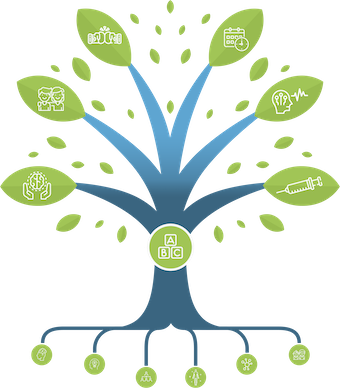What is menstrual migraine?
Menstrual migraines are headaches that are associated with your period (menstrual cycle). During a specific time of your period, hormone levels such as estrogen drops which can trigger migraine headaches.
What is the medical definition of menstrual migraine?
If you are experiencing more painful headaches either 2 days before or 3 days after the first day of bleeding, you may be suffering from menstrual migraines. Sometimes women overestimate the link between attacks and their period. We are talking about -2 to +3 days, not the week before, during and after the bleeding (friendly smile here).
There are two types that have been classified by the International Classification of Headache Disorders (https://ichd-3.org/)
1. “Pure Menstrual migraine” which means that the migraine headaches occur only during time of your periods.
Or
2. “Menstrual-related migraines” The are migraines headaches that happen with your periods but also other times outside of your period.
Who gets menstrual migraines?
Menstrual migraine is commonly seen in women between 10 to 20 years of age. The menstrual migraines typically start around the time when young teenage girls begin to have periods. Some women have a very strong link between hormones and migraines all their life: migraines start with the periods, pregnancies are easier, perimenopause is difficult and menopause is associated with a clear improvement. Genetic factors are probably at play.
Are menstrual migraines harder to treat?
In general, menstrual migraines tend to last longer, be more painful and more resistant to typical medications. Patients with frequent migraines who find a useful preventive and see their migraine frequency decrease often observe that the remaining attacks can be the menstrual ones. It is also common for women to report migraine attacks but also a «lingering headache» during their periods.
Why is it more likely to get migraines during the period?

There are many things happening in the female body during the period that could increase the risk of an attack:
- Estrogen levels drop, that makes the brain more sensitive to pain in general
- Prostaglandin levels increase, as the uterus becomes inflammatory; inflammation may trigger migraine
- Iron and magnesium levels decrease
- If the woman has a strong perimenstrual syndrome with pain and sleep difficulties, this can lead to a migraine
How can we treat menstrual migraines?
There are five key things to think about if you want to treat menstrual migraines
- Manage your other triggers during the period-at-risk
- Use an optimal acute treatment. A «stronger cocktail» than usual might be required, for example a combination of NSAID and triptan.
- Mini-prevention: cover the «at risk period»
- Hormonal approach: prevent the estrogen drop
- Standard preventive medicine: prevent all migraines
Why should I watch my other triggers during my period?
Triggers add up (See this post). Research has shown that some triggers (for example sleep deprivation) are more likely to trigger an attack during the period. Take extra care of your brain during this time.
What are the options for my menstrual attacks?
Options are pretty much the same as the ones used for attacks in general but you might need to combine or to take repeat doses (See this post, and this post). Some triptans have been studied specifically for menstrual migraine: sumatriptan, zolmitriptan, almotriptan, rizatriptan and naratriptan.
What is a «mini-prevention» and who should use it?
A mini-prevention is an approach used for women who have mostly menstrual attacks. The cycle must be predictable, as demonstrated by at least 3 months of headache diary. The idea: during the period, the threshold for migraine decreases and the risk of an attack increases. The goal of mini-prevention is to either prevent the drop in estrogen level OR to increase the brain’s resistance to attacks with a medication taken during the period at risk. The duration of the mini-prevention is usually 5-7 days around the «danger period».
What medications can I use for mini-prevention?
Triptans or NSAIDs used for mini-prevention are those that stay in the body for many hours. For example, Naproxen or Aleve stay longer in the body than Advil/ibuprofen. Frovatriptan stays longer in the body than sumatriptan. Common options for mini-prevention include:
- Naproxen
- Naratriptan
- Frovatriptan
- Zolmitriptan
- DHE (dihydroergotamine)
Always discuss medications with your physician.
If I take triptans or NSAIDs for mini-prevention, will I be at risk for medication overuse?
You are right to ask. Taking 5-7 days of NSAIDs or triptan could get you pretty close to the 10 days at risk for overuse. For this reason, women who have frequent migraines not necessarily linked to their period should consider a regular preventive treatment, not a mini-prevention. Discuss this with your physician!
How can I prevent the drop in estrogen that may cause the menstrual migraine?
To prevent drops in estrogen levels, you can take supplements of estrogen in different forms such as pills, injections or patches.
Another option is taking the birth control pill with estrogen without any drop (continuously) is a strategy commonly recommended. Women often wonder if using the pill without a placebo week is safe, as bleeding periods will often stop and that may seem unnatural. According to OBGYN associations, continuous contraception is safe (unless you should not use estrogen at all, which is a different situation).
Are there other options?
There are alternative therapies that are not prescription medications. Magnesium supplements are sometimes used. This is done by a machine that sends non-painful impulses to a nerve to help relieve pain. Typically, it involves applying this device in the area for 2 minutes 3 times a day. This device is costly and not easy to access in Canada but if you discuss it with a headache specialist you could consider it.
Whatever you do, remember to use a headache diary to get clear results. Menstrual cycles can be irregular and it is not always easy to get a clear view with your memory only.
REFERENCES
Maasumi K, Tepper SJ, Kriegler JS. Menstrual Migraine and Treatment Options: Review. Headache. 2017;57(2):194-208.
Calhoun, AH, Understanding menstrual migraine. Headaache.2018;58(4):626-630.
Post#504
Categories
THE MIGRAINE TREE
- BRANCHES
- ACUTE TREATMENTS
- DEVICES AND NEUROMULATIOIN
- PREVENTIVE TREATMENTS
- PROCEDURES AND INJECTIONS
- SELF-CARE AND LIFESTYLE
- SOCIAL LIFE
- TRUNK
- ROOTS
OTHER CATEGORIES




